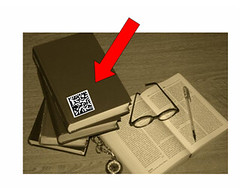It's the "things linking to things" that really fires my imagination. Not "things linking to websites", but things that link up to (and let us engage and affect) other things and other people, whether the Web is a bridge or not. That is: "If you need me to pick up some soymilk, just IM my RFID." As in: the RFID that looks like an earring, but's really a fashionable implant. Was "head-mail me" coined in The Authority?
Lots of ramifications for books here, as usual. Today I went walking through the stacks thinking through the actions of using a semacode tag. Imagine it on the book's back cover:

I pick up my treo, snap a picture of the tag (pointed to in red here), and am taken to (and here the possiblities are lots and lots, but to be somewhat specific: a message board forum, an ftp transfer for open
I've posted previously about cellphones in the library, and semacode just seals it for me -- these annoying little bite-size computers with their glintzy plastic charms dangling and chirrupy ringtones are everywhere, and they're used for so much more than talking. They're used in ways we couldn't use telephones, and they're becoming something other than telephones... Not quite computers, not quite phones, not quite dayplanners... and new uses are springing up as the technology gets sharper. Let's put the library on these machines.
In an "internet of things" (~ semacode + ~ RFIDs + ?), where books talk to users, users talk to librarians, librarians talk to books, books talk to librarians, and so on, librarians have a chance to become permanently relevant -- if we stay on top of the game. These cellphones can put a whole library in your purse or pocket, and they'll be talking to other "things" and "books" non-stop.
--
Listening: Talking Heads
Reading: Vannevar Bush
1 comment:
http://infotangle.blogsome.com/2005/12/07/the-hive-mind-folksonomies-and-user-based-tagging/
Post a Comment